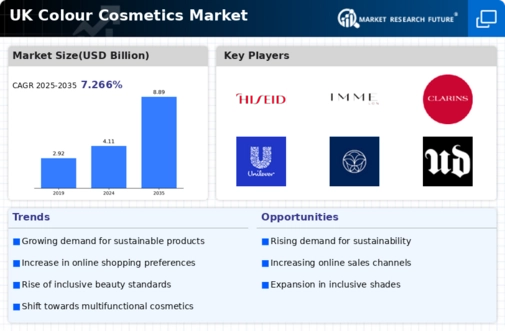Rise of E-commerce Platforms
The colour cosmetics market in the UK is experiencing a notable shift towards e-commerce platforms, which appears to be a significant driver of growth. With the increasing penetration of the internet and mobile devices, consumers are increasingly opting for online shopping due to its convenience and accessibility. In 2025, e-commerce sales in the beauty sector are projected to account for approximately 30% of total sales, indicating a robust trend towards digital purchasing. This shift not only allows brands to reach a wider audience but also enables consumers to access a diverse range of products, including niche and indie brands that may not be available in physical stores. The colour cosmetics market is thus adapting to this trend by enhancing online presence and investing in digital marketing strategies to attract and retain customers.
Influence of Social Media Trends
The influence of social media trends is a powerful driver in the colour cosmetics market in the UK. Platforms such as Instagram and TikTok have transformed the way consumers discover and engage with beauty products. The rise of beauty influencers and user-generated content has created a dynamic environment where trends can emerge rapidly, impacting purchasing decisions. In 2025, it is estimated that social media marketing will account for over 40% of advertising spend in the beauty sector, highlighting its importance. Brands are increasingly leveraging these platforms to launch products, engage with consumers, and build brand communities. This trend underscores the necessity for companies to stay attuned to social media dynamics to remain relevant and competitive in the market.
Expansion of Male Grooming Segment
The expansion of the male grooming segment is emerging as a notable driver within the colour cosmetics market in the UK. Traditionally dominated by female consumers, the market is witnessing a growing acceptance of cosmetics among men, driven by changing societal norms and increased awareness of personal grooming. In 2025, it is projected that the male cosmetics segment will grow by 25%, reflecting a shift in consumer attitudes. Brands are responding by developing targeted products for men, including foundations, concealers, and skincare items specifically designed for male skin. This diversification not only broadens the consumer base but also presents new opportunities for innovation and marketing strategies tailored to male consumers.
Innovation in Product Formulations
Innovation in product formulations is a key driver within the colour cosmetics market in the UK. Brands are increasingly focusing on developing products that cater to specific consumer needs, such as long-lasting wear, skin-friendly ingredients, and multifunctional products. For instance, the introduction of hybrid products that combine skincare benefits with makeup is gaining traction. This trend is supported by consumer demand for products that not only enhance appearance but also promote skin health. In 2025, it is estimated that the market for innovative formulations will grow by 15%, reflecting a shift towards more sophisticated and effective cosmetic solutions. As a result, companies are investing in research and development to create unique offerings that stand out in a competitive landscape.
Growing Demand for Natural Ingredients
The increasing consumer preference for natural and organic ingredients is significantly influencing the colour cosmetics market in the UK. As awareness of the potential harmful effects of synthetic chemicals rises, consumers are gravitating towards products that are perceived as safer and more environmentally friendly. In 2025, it is anticipated that the market for natural cosmetics will expand by 20%, driven by this shift in consumer behaviour. Brands are responding by reformulating existing products and launching new lines that emphasize natural ingredients, such as plant extracts and essential oils. This trend not only aligns with consumer values but also enhances brand loyalty, as customers are more likely to support companies that prioritize sustainability and health-conscious formulations.






















Leave a Comment